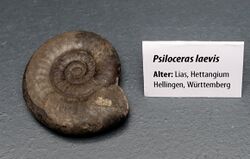Biology:Psiloceras
| Psiloceras | |
|---|---|

| |
| Psiloceras laevis | |
| Scientific classification | |
| Domain: | Eukaryota |
| Kingdom: | Animalia |
| Phylum: | Mollusca |
| Class: | Cephalopoda |
| Subclass: | †Ammonoidea |
| Order: | †Ammonitida |
| Family: | †Psiloceratidae |
| Genus: | †Psiloceras Hyatt, 1867 |
| Species[2] | |
| |
Psiloceras is an extinct genus of ammonite. Psiloceras is among the earliest known Jurassic ammonites, and the appearance of the earliest Psiloceras species form the definition for the base of the Jurassic. Unlike most earlier ammonites, which had complex shell shapes and ornamentation, Psiloceras had a smooth shell.[3][4]
Taxonomy
Almost all ammonites, with the sole exemption of a few members of the family Psiloceratidae, including Psiloceras were wiped out at the Triassic–Jurassic extinction event (201.3 million years ago).[3]
Most authors assume that Psiloceras descended from the Phyllocerataceae. P. spelae is probably the earliest species of Psiloceras.[5][6]
Biostratigraphic significance
The International Commission on Stratigraphy (ICS) has assigned the First Appearance Datum of the Psiloceras spela-group as the defining biological marker for the start of the Hettangian, 201.3 ± 0.2 million years ago, the earliest stage of the Jurassic, with the Global Boundary Stratotype Section and Point (GSSP) located at Kuhjoch pass, Karwendel Mountains, Northern Calcareous Alps, Austria, which was ratified in 2010.[7] The base of the Jurassic in Britain was historically defined by the first appearance of the ammonite Psiloceras planorbis.
Distribution
Jurassic of Argentina, Austria, Canada, China, France, Germany, New Zealand, Spain, the United Kingdom, United States [2] Psiloceras fossils are commonly found at Watchet, Somerset, England. Here smooth-shelled Psiloceras planorbis (along with other species) are to be found as usually flattened fossils in the Blue Lias.[8]
References
- ↑ Sepkoski, Jack (2002). Sepkoski's Online Genus Database. http://strata.geology.wisc.edu/jack/showgenera.php?taxon=231&rank=class. Retrieved 2014-05-28.
- ↑ 2.0 2.1 Paleobiology Database - Psiloceras. 2014-05-29.
- ↑ 3.0 3.1 "Psiloceras pacificum". New Mexico Museum of Natural History and Science. Spring 2008. http://nmnaturalhistory.org/296.
- ↑ Howarth, Michael K. (2013). "Chapter 4: Psiloceratoidea, Eodoceratoidea, Hildoceratoidea.". in Selden, Paul A.. Treatise Online, Part L (Revised) Mollusca 4, vol. 3B, Triassic and Jurassic Ammonoidea. Lawrence, Kansas: Paleontological Institute, University of Kansas. doi:10.17161/to.v0i0.4441.
- ↑ Hillebrandt, von, A.. "Paleobiogeography and Relationship of South American Hettangian (Lower Jurassic) ammonites". Institut für Angewandte Geowissenschaften II. http://www.landesmuseum.at/pdf_frei_remote/BerichteGeolBundesanstalt_46_0047.pdf.
- ↑ Hillebrandt, von, A.; Krystyn, L. (2009). "On the oldest Jurassic ammonites of Europe (Northern Calcareous Alps, Austria) and their global significance". N. Jb. Geol. Paläont. Abh. 253 (2–3): 163–195. doi:10.1127/0077-7749/2009/0253-0163. http://rogov.zwz.ru/Hillebrand,Krystyn,2009.pdf.
- ↑ Hillebrandt, A.v.; Krystyn, L.; Kürschner, W.M.; Bonis, N.R.; Ruhl, M.; Richoz, S.; Schobben, M. A. N.; Urlichs, M. et al. (2013-09-01). "The Global Stratotype Sections and Point (GSSP) for the base of the Jurassic System at Kuhjoch (Karwendel Mountains, Northern Calcareous Alps, Tyrol, Austria)" (in en). Episodes 36 (3): 162–198. doi:10.18814/epiiugs/2013/v36i3/001. ISSN 0705-3797.
- ↑ Davies, G. M. (1964). The Dorset Coast. London: Adam and Charles Black.
Wikidata ☰ Q3916646 entry
 |

